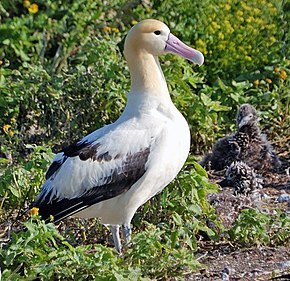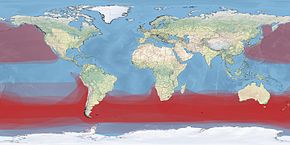Albatross
| Albatross Temporal range: Oligocene–recent Oligocene–recent |
|
|---|---|
 |
|
| Short-tailed albatross (Phoebastria albatrus) | |
| Scientific classification | |
| Kingdom: | Animalia |
| Phylum: | Chordata |
| Class: | Aves |
| Order: | Procellariiformes |
| Family: |
Diomedeidae G.R. Gray 1840 |
| Genera | |
 |
|
| Global range density (in red) | |
Diomedea
Thalassarche
Phoebastria
Phoebetria
Albatrosses, of the biological family Diomedeidae, are large seabirds allied to the procellariids, storm petrels and diving petrels in the order Procellariiformes (the tubenoses). They range widely in the Southern Ocean and the North Pacific. They are absent from the North Atlantic, although fossil remains show they once occurred there and occasional vagrants are found. Albatrosses are among the largest of flying birds, and the great albatrosses (genus Diomedea) have the largest wingspans of any extant birds, reaching up to 3.7 metres (12 feet). The albatrosses are usually regarded as falling into four genera, but there is disagreement over the number of species.
Albatrosses are highly efficient in the air, using dynamic soaring and slope soaring to cover great distances with little exertion. They feed on squid, fish and krill by either scavenging, surface seizing or diving. Albatrosses are colonial, nesting for the most part on remote oceanic islands, often with several species nesting together. Pair bonds between males and females form over several years, with the use of "ritualised dances", and will last for the life of the pair. A breeding season can take over a year from laying to fledging, with a single egg laid in each breeding attempt. A Laysan albatross, named Wisdom, on Midway Island is recognised as the oldest wild bird in the world; she was first banded in 1956 by Chandler Robbins.
...
Wikipedia
